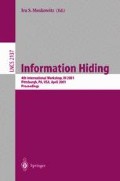Abstract
A c-secure code with ∈-error is one of the fingerprinting codes robust against a collusion attack. The purpose of this study is to construct a new c-secure code which has a shorter code length for a large-scale collusion than ever proposed. We call this code a c-secure CRT code. Furthermore, we investigate possible approaches to make this code robust against random-error addition. Two approaches to this problem have already been proposed. One is a combination of an error-correcting code and a c-secure code. The other is to make inner codes of the c-secure code resilient against random-error addition. We propose a brand-new approach, called weak ID elimination, which is a modification of its outer code. We also propose a method to estimate whether the size of a coalition exceeds the traceability of this code.
Access this chapter
Tax calculation will be finalised at checkout
Purchases are for personal use only
Preview
Unable to display preview. Download preview PDF.
References
Wagner, N. R., “Fingerprinting,” Proceedings of the 1983 Symposium on Security and Privacy, Oakland, California, U. S. A., 25–27 Apr. 1983, Technical Committee on Security & Privacy, IEEE Computer Society, 18–22, 1983.
Blakley, G. R., C. Meadows and G. Purdy, “Fingerprinting Long Forgiving Messages,” Proceedings of Advanced Cryptology-CRYPTO‘85, Lecture Notes in Computer Science, Vol. 218, Springer-Verlag, 180–189, 1986.
Boneh, D. and J. Shaw, “Collusion-Secure Fingerprinting for Digital Data,” Proceedings of Advances in Cryptology-CRYPTO’95, Santa Barbara, California, U. S. A., 27–31 Aug. 1995, Lecture Notes in Computer Science, Vol. 963, Springer-Verlag, 452–465, 1995.
Suzuoki, M., H. Watanabe and T. Kasami, “A Scheme of Making Collusion-Secure Watermark,” Proceedings of the 1997 Symposium on Cryptography and Information Security, SCIS’97, Fukuoka, Japan, 29 Jan.–1 Feb. 1997, 31B, 1997 (in Japanese).
Yoshida, J., K. Iwamura and H. Imai, “A Coding Method for Collusion-Secure Watermark and Less Decline,” Proceedings of the 1998 Symposium of Cryptography and Information Security, SCIS‘98, Shizuoka, Japan, 28–31 Jan. 1998, 10.2.A, 1998 (in Japanese).
Chor, B., A. Fiat and M. Naor, “Tracing traitors,” Proceedings of Advanced Cryptology-CRYPTO”94, Santa Barbara, California, U. S. A., 22-25 Aug. 1994, Lecture Notes in Computer Science, Vol. 839, Springer-Verlag, 257–270, 1994.
Alon, N., J. H. Spencer and P. Erdös, “The Probabilistic Method,” John Wiley & Sons, Inc., New York, 1992.
Lindkvist, T., “Fingerprinting digital document,” Ph.D. thesis, LIU-TEK-LIC-1999:56, Linköping University, 1999.
Wiberg, N. and T. Lindkvist, “On the Performance of Certain Collusion-Secure Fingerprinting Codes,” http://www.it.isy.liu.se/research.
Löfvenberg, J., “Random Codes for Digital Fingerprinting,” LIU-TEK-LIC-1999:07, Linköping University, 1999.
Goldreich, O., D. Ron and M. Sudan, “Chinese Remaindering with Errors,” Proceedings of the Thirty-First Annual ACM Symposium on Theory of Computing, 225–234, 1999.
Boneh, D., “Finding Smooth Integers in Short Intervals Using CRT Decoding,” Proceedings of the Thirty-Second Annual ACM Symposium on Theory of Computing, 265–272, 2000.
Bleichenbacher, D. and P. Q. Nguyen, “Noisy Polynomial Interpolation and Noisy Chinese Remaindering,” Proceedings of the Advances in Cryptology-EURO-CRYPT 2000, Bart Preneel (ed.), Bruges, Belgium, 14–18 May 2000, Lecture Notes in Computer Science, Vol. 1807, Springer-Verlag, 53–69, 2000.
Guth, H.-J. and B. Pfitzmann, “Error-and Collusion-Secure Fingerprinting for Digital Data,” Proceedings of the Third International Worksho p, Information Hiding, IH’99, Andreas Pfitzmann (ed.), Dresden, Germany, 29 Sept.–1 Oct. 1999, Lecture Notes in Computer Science, Vol. 1768, Springer-Verlag, 134–145, 2000.
Author information
Authors and Affiliations
Editor information
Editors and Affiliations
Rights and permissions
Copyright information
© 2001 Springer-Verlag Berlin Heidelberg
About this paper
Cite this paper
Muratani, H. (2001). A Collusion-Secure Fingerprinting Code Reduced by Chinese Remaindering and Its Random-Error Resilience. In: Moskowitz, I.S. (eds) Information Hiding. IH 2001. Lecture Notes in Computer Science, vol 2137. Springer, Berlin, Heidelberg. https://doi.org/10.1007/3-540-45496-9_22
Download citation
DOI: https://doi.org/10.1007/3-540-45496-9_22
Published:
Publisher Name: Springer, Berlin, Heidelberg
Print ISBN: 978-3-540-42733-9
Online ISBN: 978-3-540-45496-0
eBook Packages: Springer Book Archive

